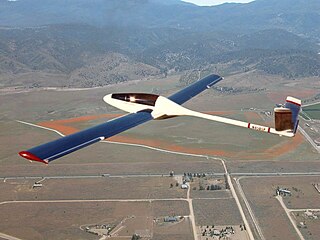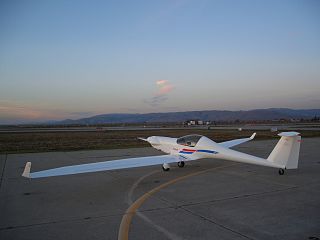A motor glider is a fixed-wing aircraft that can be flown with or without engine power. The FAI Gliding Commission Sporting Code definition is: a fixed-wing aerodyne equipped with a means of propulsion (MoP), capable of sustained soaring flight without thrust from the means of propulsion.
Carden Aero Engines Limited was a 1930s British fixed-wing aero-engine manufacturer, based at Heston Aerodrome.

The Monnett Monerai is a sailplane that was developed in the United States in the late 1970s for homebuilding. It is a conventional pod-and-boom design with a V-tail and a mid-mounted cantilever wing of constant chord.

Leslie Everett Baynes, AFRAeS was an English aeronautical engineer.
Abbott-Baynes Sailplanes Ltd. was a 1930s glider manufacturing company based at Wrecclesham, near Farnham, Surrey. It was founded as a subsidiary of E. D. Abbott Ltd in 1931 by L. E. Baynes and E. D. Abbott to build the Scud, a glider designed by Baynes in 1930, the prototype of which was built by Brant Aircraft Limited at Croydon Airport. The Scud was popular, and in 1932 a development of it, the Scud II model was launched. In 1935, a Scud II flown by Mungo Buxton took the British Height Record for a glider to 8,750 ft (2,666 m).

The AMS-Flight Carat A is a single-seat, high performance motorglider. The sailplane was originally designed and built by Technoflug in Germany and is now manufactured by AMS-Flight in Slovenia.

The Carden-Baynes Bee was a 1930s British two-seat aircraft, with twin engines in pusher configuration buried in the wings. The wings rotated for storage. Financial problems limited the Bee to a single flight.

The Comper Streak was a single-engined, single-seat racing monoplane built in the UK in the mid-1930s. It was not successful as a racer and only one was produced.
The Comper Kite was a single-engined, two-seat touring monoplane built in the UK, derived from the contemporary Comper Streak racer. Only one was built.
The TeST TST-13 Junior is a single-seat touring motor glider with a nose-mounted engine, built by TeST in Czech Republic. It is an all composite design which succeeded the TeST TST-9 Junior motor glider in production, incorporating some features of the TeST TST-10 Atlas sailplane, including its wing.

The Bowlus/Nelson BB-1 Dragonfly is an American, two seat, strut-braced, high-wing motor glider that was developed from the Bowlus BA-100 Baby Albatross glider by Hawley Bowlus.

The Mignet HM.14Flying Flea is a single-seat light aircraft first flown in 1933, designed for amateur construction. It was the first of a family of aircraft collectively known as Flying Fleas.

Stephen Villiers Appleby was an English pilot and a leading proponent of the Mignet Pou-du-Ciel "Flying Flea" aircraft.
The Brokker was a single seat glider entered into the first British gliding endurance competition, held at Itford Hill in 1922. It combined the wing of a Fokker D.VII with an engineless Bristol F.2 Fighter fuselage. It flew well in the stiff winds of the last day and achieved the third longest flight.

The Abbott-Baynes Scud 1 was a parasol-winged single seat glider intended to introduce pilots to soaring flight. It was built in the United Kingdom and first flew in 1931.

The Abbott-Baynes Scud 2 was a 1930s high-performance sailplane, built in the UK. It was a development of the intermediate-level Scud 1 with a new, high aspect ratio wing.
The Hirth Hi 20 MoSe was a German motor glider designed in the late 1930s. Based on the Göppingen Gö 4 side-by-side seat training glider, it had a foldaway propeller, column-mounted above the fuselage and shaft-driven by a small internal piston engine.
The Aerola Alatus is a Ukrainian mid-wing, single-seat, glider and motor glider, designed and produced by Aerola of Kyiv.
The Bonomi BS.19 Alca was a single seat, tractor configuration motor glider, designed and built in Italy shortly before World War II. It had an unusual retractable undercarriage used only for take-offs. Only one was built.
The Bonomi BS.22 Alzavola was a training motor glider, intended to acquaint capable glider pilots with the characteristics of powered aircraft. The sole example was designed and built in Italy in the mid-1930s.









